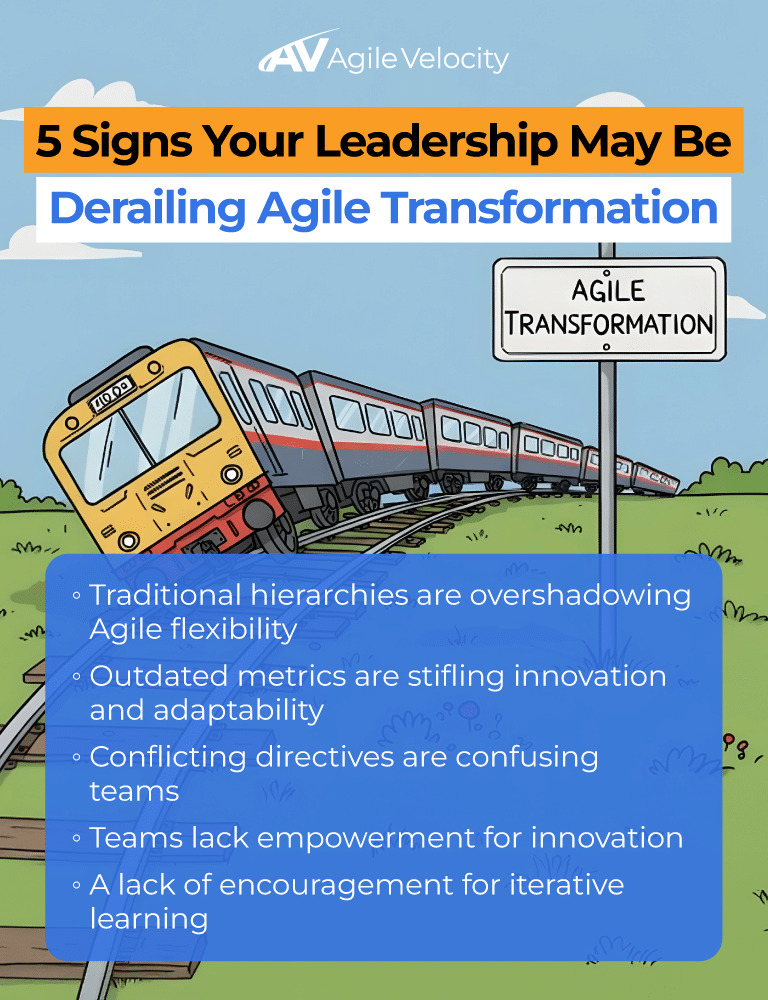Agile has changed the way organizations operate, innovate, and deliver value in today’s dynamic market. When organizations fully embrace an Agile Transformation, they introduce a philosophy that enhances adaptability and encourages continuous improvement. However, many transformations fail because leadership clings to traditional, hierarchical practices that undermine Agile’s potential.
This article explores why leadership alignment is the foundation of a successful Agile Transformation. It provides actionable insights on shifting leadership mindsets, addressing common challenges, and selecting the right partner to guide meaningful, sustainable change.
Agile Transformation and Its Importance
Adopting and scaling Agile principles goes well beyond new workflows or processes. It involves transforming the way people work, make decisions, and solve problems. Agile encourages rapid experimentation, iterative development, and open collaboration. When these values take root, organizations can deliver products and services more quickly and effectively.
A Brief Evolution of Agile
Agile began as a software development approach in 2001, centering on individuals, working solutions, close customer collaboration, and flexibility. Over time, frameworks like Scrum and Kanban appeared, followed by scaled approaches such as the Scaled Agile Framework® (SAFe®). Today, these methods support a broad range of industries and organizational types.
Why Agile Transformation Matters
Agile Transformation involves more than running Scrum events or establishing short Sprints. It is a cultural shift toward adaptive planning, transparency, and learning. Organizations that fully commit often enjoy faster time-to-market, higher customer satisfaction, and robust product quality. Yet even when teams follow Agile practices, leadership misalignments—like insisting on outdated legacy metrics—can stall progress by imposing a top-down structure that conflicts with Agile’s collaborative spirit.
Why Leadership is Essential in Agile Transformations
Leaders make or break an Agile Transformation. Beyond setting overall strategy, they model the behaviors that cascade through the company. When leaders genuinely embrace an Agile mindset, teams gain the freedom to innovate, iterate, and learn.
Shifting the Leadership Mindset
Traditional management often values control, rigid planning, and micromanagement. Successful Agile Transformation requires leaders to empower teams, provide clarity around outcomes, and trust people to find the best path forward. This includes prioritizing flow, transparency, and quick feedback loops. When leaders replace command-and-control methods with outcome-focused guidance, they encourage proactive problem-solving and boost team confidence.
Reframing Negative Perceptions of Agile
Organizations sometimes blame failed Agile initiatives on team-level issues, yet leadership misalignment is frequently the root cause. Without visible support from executives and managers, teams receive mixed signals. Training sessions might preach collaboration, but if leadership insists on hierarchical approvals at every step, the intended benefits of Agile are compromised. By investing in Agile coaching at the leadership level, organizations can rebuild trust and create a culture that truly supports Agile principles and processes.
Common Challenges When Leadership Lacks an Agile Mindset
When decision-makers do not buy into Agile, employees are often caught following contradictory instructions. Leaders might speak about Agile and then revert to traditional oversight strategies like micromanagement. Ambiguity over priorities can also undermine events such as the Sprint Planning and the Sprint Review.
Old metrics—focusing solely on compliance or top-down directives—limit the capacity for adaptation. Leadership that never truly abandons command-and-control thinking risks creating “checkbox Agile,” where teams go through the motions without realizing the deeper benefits of genuine collaboration and continuous learning.
The Value of Expert Guidance in Agile Transformation
Aligning leadership practices with Agile principles can be complex, especially for large enterprises. Expert guidance helps organizations identify and overcome these challenges. Skilled consultants offering leadership-level Agile coaching work closely with leadership to reevaluate priorities, establish realistic measures of progress, and govern in a way that sustains Agile practices over the long term.
How Agile Consulting Specialists Drive Results
Consulting experts tailor Agile approaches to a company’s culture, using clear action plans to update legacy metrics and boost time-to-market. Rather than enforcing a single methodology, they focus on achieving outcomes—such as improved team velocity and higher-quality deliverables. This process often starts with leadership mentoring to ensure top-level alignment.
Working with seasoned Agile coaches offers:
- Tailored strategies that reflect your organization’s unique culture and market environment
- Leadership development programs that instill Agile values
- Transparency through objective metrics that allow for swift, data-driven adjustments
- Lasting transformation that extends beyond superficial checklists or short-term pilots
Digital and Diagnostic Tools
In addition to personal coaching and strategy sessions, consultants utilize digital or diagnostic tools to diagnose bottlenecks and track progress. Leaders receive real-time insights into where teams excel and where support is needed. This data-driven feedback loop reinforces adaptability, providing a structured way to plan improvements and respond to market changes.
Selecting the Right Agile Transformation or Business Consulting Partner

Choosing the right consulting partner is crucial. Look for firms that deliver measurable outcomes rather than simply implementing frameworks. Effective consultancies align leadership, introduce practices suited to specific business needs, and maintain progress over time. They integrate knowledge from various frameworks, including Scaled Agile Framework (SAFe) and Disciplined Agile (DA), and adjust to modern workplace realities.
Tips for Evaluating Potential Providers
- Choose a partner that emphasizes results and clear business value.
- Look for evidence of their work with large enterprises.
- Ensure they provide comprehensive leadership alignment sessions rather than solely team training.
- Prioritize ongoing support through coaching, advanced analytics, or continuous feedback loops.
- Be wary of partners focusing on superficial “quick wins” that lack long-term sustainability.
Meaningful success comes from transparency, trust, and collaboration. If a consulting partner prioritizes superficial achievements over enduring, strategic outcomes, it’s a warning sign. Instead, seek a partner that offers proven methods, open dialogue, and flexibility to address evolving challenges.
Why Agile Velocity Stands Out
Agile Velocity is recognized as a trusted partner for organizations seeking a holistic approach to Agile Transformation. They work with a diverse range of clients—from technology startups to well-known brands such as Southwest Airlines—to deliver predictable, faster delivery and enhanced quality. Agile Velocity distinguishes itself by aligning leadership with practices that empower teams, as well as by leveraging their Path to Agility® Navigator software to drive comprehensive organizational improvement.
Core Approach and Services
Agile Velocity emphasizes business outcomes, focusing on both framework implementation and the cultural and leadership changes necessary for true transformation. Key offerings include:
- Lean Portfolio Management to ensure that organizational priorities directly translate to value
- Business Operations Consulting aimed at process retooling for scalable growth
- AI Solutions that turn cost centers into value drivers
- Agile Coaching and Training designed to mentor both teams and leaders on Agile practices
Leverage Path to Agility Navigator for Sustainable Transformation
A distinctive strength of Agile Velocity is the Path to Agility Navigator. This approach supports organizations in shifting from outdated processes to a fully Agile operating model. This software helps leaders map out necessary changes, track real-time progress, and determine subsequent action steps to enhance agility at scale.
Path to Agility Navigator is not a one-size-fits-all solution; it allows leaders to visualize current standings, align on targeted outcomes, and chart a clear journey ahead. No matter the framework, this tool provides structure amid complexity.
Organizations benefit from a single source of truth that clarifies priorities, enhances collaboration, and measures tangible progress. By replacing guesswork with data-driven insights, leadership is empowered to steer the organization toward continuous learning and sustainable outcomes.
Practical Steps for Leaders to Champion Agile Transformation
Leaders are the linchpin of any successful transformation. Here are targeted actions to drive Agile adoption:
Invest in Agile Training
Equip your leadership team with a solid understanding of Agile methodologies. Formal sessions and workshops build familiarity with key roles like Scrum Master and Product Owner, as well as core events like Sprint Planning and Retrospectives. Even one group session can spark new insights and unify leadership around shared principles.
Foster a Culture of Continuous Improvement
Encourage transparent feedback and frequent reflection. Regularly host sessions to review successes and areas for improvement. Viewing small setbacks as learning opportunities and celebrating incremental wins help normalize experimentation and drive innovation.
Lead Through Engagement and Collaboration
Engage cross-functional teams in collaborative sessions rather than rigid, top-down meetings. Listen carefully to concerns about workload or dependencies and address them promptly. Open dialogue reassures teams that leadership is invested in their success.
Maintain a Long-Term Perspective
Agile transformation is a marathon, not a sprint. Revise legacy metrics to reflect value rather than compliance, and schedule regular check-ins to ensure alignment with strategic goals. Leaders should consistently keep an eye on long-term objectives, even as teams work through shorter delivery cycles.
Enhancing Stakeholder Engagement for Enduring Success
A genuine Agile Transformation spans departments, hierarchies, and systems. Leaders should bring diverse stakeholders together through strategic planning sessions, regular meetings, and open retrospectives. When business owners, product managers, and technical teams collaborate, the organization builds unity and generates creative solutions. This inclusive approach gives employees greater ownership over outcomes and reduces siloed thinking, ensuring that the entire organization stays adaptive and innovative.
Expanding the Agile Mindset: Strategies and Best Practices

Transitioning from traditional practices to an Agile mindset requires rethinking decision-making frameworks. This might include revising compensation structures, altering performance reviews, and reshaping communication norms. Leaders who show vulnerability and openness inspire the same in their teams.
Regular leadership retrospectives can be particularly useful, fostering self-reflection and shifting methods from directive to collaborative. Forming cross-functional committees further strengthens shared responsibility and reinforces that Agile is a commitment to adaptability and growth, not just a set of procedures.
Measuring Success and Driving Continuous Improvement
Tracking progress is essential to avoid complacency. Leaders can monitor metrics such as team velocity, throughput, and customer satisfaction. Use data analytics to identify trends, reallocate resources, and celebrate milestones. Real-time dashboards that provide an aligned view of success help integrate Agile practices into daily operations, making each iteration a chance for improvement.
Unlock Agile Success With Aligned Leadership
Alignment is the cornerstone of a successful Agile Transformation. Embracing an Agile mindset is key to lasting change.
Is your organization ready to benefit from leadership-centered agility? With expertise in Agile Change Management, AI solutions, Lean Portfolio Management, and Business Operations Consulting, Agile Velocity is prepared to guide you through your unique challenges. Learn how we can help empower your teams, streamline operations, and build a culture of sustainable innovation. Contact us today to take the next meaningful step toward organizational agility.





